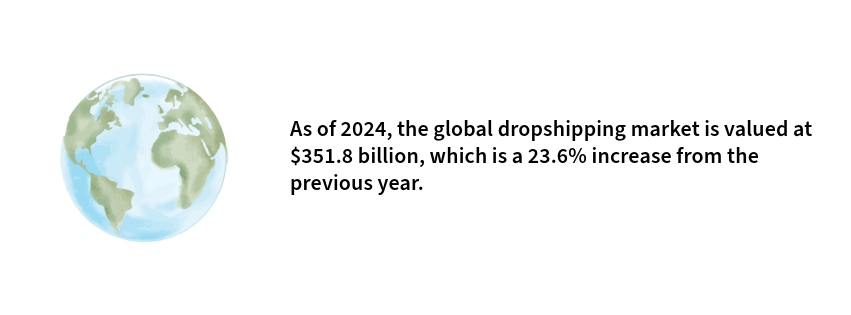Is Dropshipping Profitable in 2024? Exploring the Potential of a Low-Risk, Low-Cost Business Model

What is dropshipping?
Dropshipping is a game-changing business model that empowers entrepreneurs to run online stores without the burden of managing inventory. Instead of stocking products, the retailer partners with a supplier who holds the inventory. When a customer places an order, the supplier ships the product directly to them. This approach significantly lowers financial risk, as you don’t need to invest in inventory upfront, and offers incredible flexibility to quickly add new products or explore different niches.
Dropshipping is great for beginners. This model offers significant advantages, especially for those just starting out.
However, it’s not without its challenges. Profit margins can be slimmer, and relying on third-party suppliers means less control over product quality and shipping times. But for those eager to break into eCommerce with minimal investment, dropshipping presents an exciting opportunity. Imagine running a business where you can focus on marketing and growth while leaving the logistics to someone else. Despite the hurdles, the potential rewards make dropshipping a compelling choice for aspiring entrepreneurs looking to make their mark in the digital world.
But the big question for 2024 is: Is dropshipping still profitable? With evolving market trends, increased competition, and changes in consumer behavior, it’s crucial to understand how this model can generate income today. In the following sections, we’ll explore the profitability of dropshipping in 2024, considering the latest industry insights, strategies for success, and potential pitfalls to avoid.
The current state of the dropship market
Overview of Market Trends in 2024
In 2024, dropshipping continues to thrive, driven by advancements in technology and shifts in consumer preferences. Key trends include a growing demand for personalized shopping experiences, the rise of mobile commerce (mCommerce), and a strong push towards sustainability. Dropshippers who can offer tailored, eco-friendly products while ensuring mobile-friendly experiences are likely to succeed in this increasingly competitive landscape.
Impact of Global eCommerce Growth on Dropshipping
Global eCommerce is expanding rapidly, opening up new opportunities for dropshippers. With more consumers shopping online worldwide, the potential customer base is larger than ever. However, this growth also brings heightened competition. To stay profitable, dropshippers need to focus on efficient operations, exceptional customer service, and smart marketing strategies.
Key Niches and Product Categories That Are Thriving
Several niches are particularly profitable in 2024. Health and wellness products, tech gadgets, eco-friendly items, and pet products are all in high demand. Dropshippers who tap into these trending categories can maximize their success by offering what consumers are actively searching for.
Top Niches:
- Health and Wellness
- Tech Gadgets
- Eco-Friendly Products
- Pet Products
- Home Office Equipment
- Home & Garden
Profit Margins in Dropshipping
Typical Profit Margins in 2024
In 2024, typical dropshipping profit margins range from 10% to 30%, depending on the product category, supplier pricing, and competition. While these margins are modest, they can be sufficient when scaled across multiple sales.
How to Optimize Profit Margins
To boost your profit margins, focus on high-demand, low-competition products where you can charge a premium. Negotiating better deals with suppliers, reducing shipping costs, and automating processes to lower operational expenses can also help increase profitability.
Factors That Can Eat Into Your Profits
Several factors can reduce your profits, including high shipping costs, payment processing fees, and returns. Additionally, increased competition may force you to lower prices, further squeezing margins. Managing these costs effectively is key to maintaining profitability in dropshipping.
Choosing the Best Supplier
Selecting the right supplier is crucial for the success of your dropshipping business. Reliable suppliers ensure product quality, timely delivery, and competitive pricing, all of which directly impact your profit margins and customer satisfaction. Here’s a look at three top dropshipping suppliers to consider in 2024:
AutoDS is an all-in-one dropshipping platform that automates product sourcing, order processing, and inventory management. It offers access to millions of products from various suppliers, making it easy to find trending items. AutoDS also integrates seamlessly with popular eCommerce platforms like Shopify, allowing you to manage your entire dropshipping operation from a single dashboard. Its automation features, such as price optimization and automated order fulfillment, can help streamline your business and save time.
Doba connects you with a vast network of suppliers, offering a wide range of products across multiple categories. It simplifies the dropshipping process by allowing you to add products directly to your online store with just a few clicks. Doba also provides detailed supplier information and product data, helping you make informed decisions about which items to sell. With its robust filtering options, you can easily find high-margin products and reliable suppliers, ensuring your business remains competitive.
Dropship with Doba
SaleHoo is a directory of verified suppliers, making it a trusted resource for finding quality products and avoiding unreliable vendors. It offers access to over 8,000 suppliers and millions of products, with a focus on ensuring that each supplier meets high standards for reliability and service. SaleHoo also provides tools for market research, helping you identify profitable niches and trending products. If you’re new to dropshipping, SaleHoo’s comprehensive training materials and customer support can be invaluable in getting your business up and running smoothly.
By carefully choosing the right supplier, you can ensure a smoother operation, higher profit margins, and better customer satisfaction, all of which are essential for success in dropshipping.
Product Research
Product research is the backbone of a successful dropshipping business. Identifying the right products to sell can make or break your venture. In 2024, with increased competition and rapidly changing consumer preferences, it’s more important than ever to use effective tools for product research. One such tool that has gained popularity among dropshippers is Zik Analytics.
Zik Analytics is a fantastic tool for product research and dropshipping. Zik provides you with insights on what your competitors are selling and even gives you links to suppliers so you can source the product yourself.
How Zik Analytics Can Help
Zik Analytics is a powerful product research tool designed specifically for dropshippers. It offers a comprehensive suite of features that make it easier to identify profitable products, understand market trends, and analyze your competitors. Here’s how Zik Analytics can give you an edge:
Market Research: Zik Analytics provides real-time data on top-selling items across major platforms like eBay and Amazon. This data helps you identify trending products that are in high demand but have low competition, giving you a better chance of capturing market share.
Competitor Analysis: The tool allows you to spy on your competitors by analyzing their best-selling products, pricing strategies, and sales volumes. This insight enables you to make informed decisions about which products to sell and how to price them competitively.
Keyword Research: Zik Analytics helps you find the most relevant keywords for your product listings. By optimizing your titles and descriptions with these keywords, you can improve your search engine rankings, attract more customers, and increase your sales.
Niche Identification: Zik Analytics makes it easy to discover untapped niches with high profit potential. By analyzing niche-specific data, you can find profitable products that cater to specific customer needs, giving you an advantage in less saturated markets.
To maximize Zik Analytics, use its data-driven insights to guide your product choices. Begin by exploring trending categories to find products with strong demand and manageable competition. Next, analyze competitors to see what’s working and how you can stand out. Lastly, optimize your product listings with effective keywords to make them easily discoverable by buyers.
Setting up Your Dropshipping Website
Creating a well-designed, user-friendly website is crucial to the success of your dropshipping business. Your website is the face of your brand and the platform where customers will browse, purchase, and interact with your products. Here’s how to set up a professional dropshipping website that attracts and converts visitors:
1. Choose the Right eCommerce Platform
We recommend the website providers:
The first step is selecting the right eCommerce platform for your dropshipping business. Popular options include Shopify, Hostinger, and Wix. Each platform offers unique features, so choose one that fits your needs:
Shopify is a powerful and popular ecommerce platform that makes the use of themes. Integrates with suppliers and more. You can get started for just $1!
Hostinger is a powerful website hosting platform that can integrate with WordPress to create powerful websites.
Once you’ve chosen a platform, it’s time to design your store. Focus on creating a clean, professional layout that makes it easy for customers to navigate and find products. Use high-quality images, clear product descriptions, and simple, intuitive menus. Your website’s design should reflect your brand identity and appeal to your target audience.
Mobile Optimization: Ensure your website is fully optimized for mobile devices, as more customers are shopping on their phones and tablets. A responsive design that adapts to different screen sizes will improve the user experience and increase your chances of making sales.
Trust and Credibility: Build trust with your visitors by including clear policies on shipping, returns, and privacy. Adding customer reviews, testimonials, and security badges can also enhance your site’s credibility and encourage purchases.
Next, Add Essential Pages
Your website should include more than just product listings. Make sure to add the following essential pages:
- About Us: Share your brand’s story, mission, and values to connect with customers on a personal level.
- Contact Us: Provide clear contact information and a form for customers to reach out with questions or concerns.
- Shipping and Returns: Clearly outline your shipping methods, costs, and return policies to set customer expectations.
- Privacy Policy and Terms of Service: Include these legal pages to protect your business and inform customers about how their data will be used.
Integrate with Dropshipping Tools
Finally, integrate your website with dropshipping tools to automate and streamline your operations. Tools like AutoDS and Doba can help you add your products to your store, manage inventory, process orders, and track shipments, saving you time and reducing manual tasks. Ensure these tools are set up correctly and fully integrated with your eCommerce platform to keep your business running smoothly.
By following these steps, you’ll be well on your way to setting up a professional, user-friendly dropshipping website that effectively converts visitors into customers. A well-crafted website not only enhances your brand’s image but also plays a crucial role in driving sales and growing your business.
Marketing
Marketing is the driving force behind a successful dropshipping business. With the right strategies, you can attract visitors, convert them into customers, and build a loyal customer base. Here’s how to effectively market your dropshipping business in 2024:
1. Harness the Power of Social Media
Social media platforms like Instagram, Facebook, and TikTok are essential tools for reaching your target audience. Create engaging content that showcases your products, shares customer reviews, and highlights promotions. Use visually appealing images and videos to catch attention and encourage shares. Additionally, run targeted ads on these platforms to reach potential customers based on their interests, demographics, and online behaviors.
- Instagram and TikTok: Focus on high-quality visuals and short, engaging videos. Collaborate with influencers and use popular hashtags to increase your reach.
- Facebook: Utilize Facebook Ads to create targeted campaigns that drive traffic to your store. You can also build a community through a Facebook group dedicated to your niche.
2. Invest in Content Marketing
Content marketing helps you build brand authority and attract organic traffic to your website. Start a blog where you can publish articles, how-to guides, and product reviews related to your niche. This not only improves your SEO but also provides value to your audience, encouraging them to trust and engage with your brand.
- Blogging: Write informative posts that address common questions or challenges your customers face. Incorporate relevant keywords to improve your search engine rankings.
- Video Content: Create product demonstrations, unboxing videos, and tutorials that can be shared on your website, YouTube, and social media platforms.
3. Leverage Email Marketing
Email marketing is one of the most effective ways to nurture relationships with your customers and drive repeat sales. Build an email list by offering incentives like discounts or exclusive content in exchange for sign-ups. Use personalized email campaigns to promote new products, share special offers, and keep your audience informed about your brand.
- Newsletters: Regularly send out newsletters that include product updates, promotional codes, and curated content related to your niche.
- Abandoned Cart Emails: Implement automated emails to remind customers about items they left in their cart, encouraging them to complete their purchase.
4. Optimize for Search Engines (SEO)
Search engine optimization (SEO) is crucial for driving organic traffic to your dropshipping store. Research relevant keywords and incorporate them into your product titles, descriptions, and blog posts. Focus on creating high-quality content that answers customer queries and provides valuable information. Additionally, ensure your website is fast, mobile-friendly, and easy to navigate.
- On-Page SEO: Optimize your product pages with descriptive titles, detailed descriptions, and relevant keywords.
- Backlink Building: Increase your site’s authority by earning backlinks from reputable websites in your niche.
5. Utilize Influencer Marketing
Influencer marketing can be a powerful way to build brand credibility and reach a larger audience. Partner with influencers who align with your brand and have a following that matches your target market. These influencers can create authentic content that showcases your products, driving traffic and sales to your store.
- Micro-Influencers: Consider working with micro-influencers who, while having smaller followings, often boast highly engaged audiences.
- Affiliate Marketing: Set up an affiliate program where influencers earn a commission for each sale they drive to your store.
6. Run Targeted Paid Advertising
Paid advertising on platforms like Google Ads and Facebook Ads can quickly generate traffic to your dropshipping store. Use Google Ads to capture customers actively searching for products like yours, and Facebook Ads for visually driven campaigns targeting specific demographics. Regularly monitor and optimize your ads to maximize return on investment (ROI).
- Google Shopping Ads: Promote your products directly in Google search results with eye-catching images and competitive prices.
- Retargeting Ads: Reach out to customers who have previously visited your site but didn’t make a purchase, reminding them of your products.
By implementing these marketing strategies, you can effectively promote your dropshipping business, increase traffic, and drive sales in 2024. The key to successful marketing lies in consistency, creativity, and staying responsive to the ever-changing digital landscape.
Continuously Analyze and Adapt your Strategy
Success in dropshipping doesn’t come from a set-it-and-forget-it approach. The market is dynamic, and what works today might not work tomorrow. That’s why it’s crucial to regularly analyze the performance of your marketing strategies and be prepared to make adjustments as needed. Use analytics tools to track key metrics like website traffic, conversion rates, and ROI on your marketing campaigns. If you notice certain strategies aren’t delivering the expected results, don’t hesitate to pivot—whether that means refining your SEO efforts, experimenting with new ad formats, or exploring different social media platforms.
In addition, consider diversifying your supplier base. Relying on a single supplier can put your business at risk if they encounter stock issues, shipping delays, or quality problems. By using multiple suppliers like AutoDS, Doba, and SaleHoo, you can ensure a more stable and reliable operation. This approach also gives you access to a broader range of products, allowing you to better meet customer demands and stay competitive.
Conclusion: Dropshipping is Profitable in 2024 and Beyond
In conclusion, dropshipping remains a profitable business model in 2024, offering vast opportunities for entrepreneurs willing to put in the work. By choosing the right products, setting up a professional website, and implementing effective marketing strategies, you can build a successful dropshipping business. The key to sustained profitability lies in staying adaptable—continuously analyzing your performance, refining your approach, and leveraging multiple suppliers to ensure smooth operations.
As global eCommerce continues to grow, dropshipping is poised to remain a viable and lucrative option for both new and experienced online sellers. With the right tools and strategies, you can capitalize on this growth and carve out your own piece of the booming eCommerce market. Whether you’re just starting out or looking to scale your existing business, dropshipping in 2024 offers a pathway to success.

















Post Comment